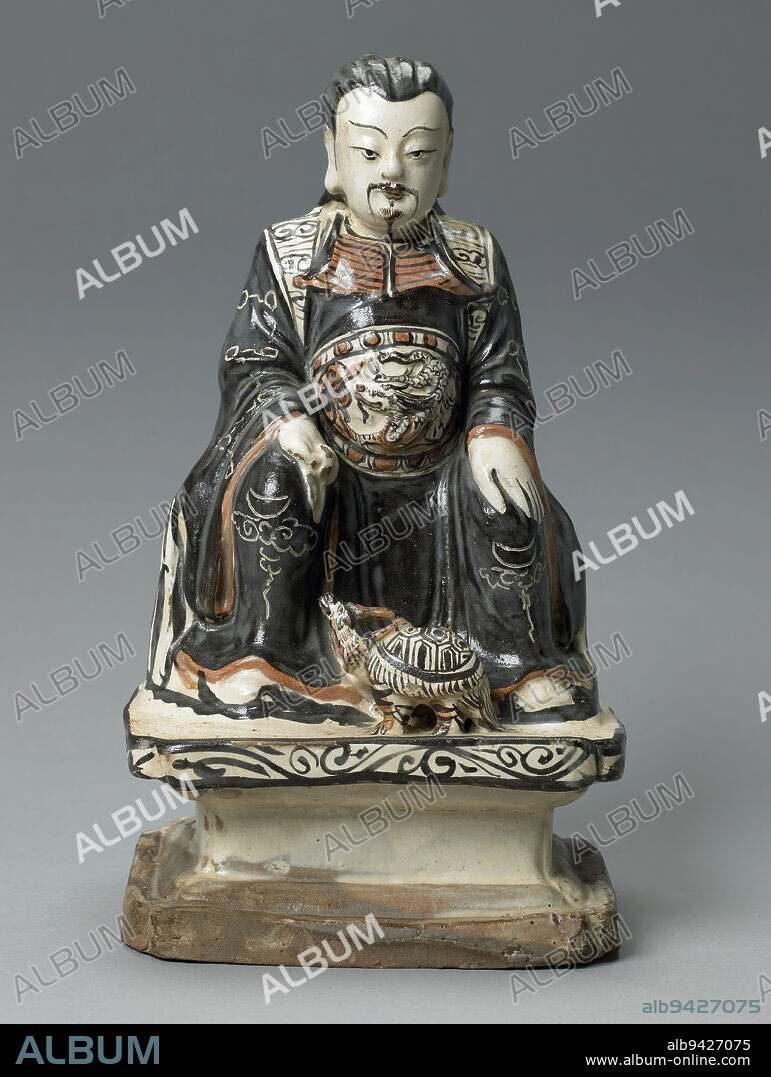alb9427075
Chen-Wu, The Taoist Deity of the North, 14th-15th century, 11 1/2 x 5 1/4 x 6 1/2 in. (29.21 x 13.34 x 16.51 cm), Tz'u-chou ware Slip-coated stoneware with dark brown and russet brown painted décor under a clear glaze., China, 14th-15th century, The origins of the deity Zhenwu (perfected warrior) go back to the Warring States (3rd century b.c.) and Han dynasty (206 b.c.-220 a.d.) periods. At that time, he was known as Xuanwu (the dark warrior), and was simply represented by a tortoise entwined by a snake. Xuanwu was the ancient symbol of the north and often appeared with three other animals: the dragon, red bird, and tiger, to symbolize the four directions. The transformation of Xuanwu from a snake-entwined tortoise to the Daoist deity Zhenwu, represented as a robust human-form warrior, occurred around 1000 a.d. The period of Zhenwu's greatest popularity was the Ming dynasty (1368-1644).

|
Ajouter à une autre Lightbox |
|
Ajouter à une autre Lightbox |



Avez-vous déjà un compte? S'identifier
Vous n'avez pas de compte ? S'inscrire
Acheter cette image.
Sélectionnez l'usage:

Légende:
Voir la traduction automatique
Chen-Wu, The Taoist Deity of the North, 14th-15th century, 11 1/2 x 5 1/4 x 6 1/2 in. (29.21 x 13.34 x 16.51 cm), Tz'u-chou ware Slip-coated stoneware with dark brown and russet brown painted décor under a clear glaze., China, 14th-15th century, The origins of the deity Zhenwu (perfected warrior) go back to the Warring States (3rd century b.c.) and Han dynasty (206 b.c.-220 a.d.) periods. At that time, he was known as Xuanwu (the dark warrior), and was simply represented by a tortoise entwined by a snake. Xuanwu was the ancient symbol of the north and often appeared with three other animals: the dragon, red bird, and tiger, to symbolize the four directions. The transformation of Xuanwu from a snake-entwined tortoise to the Daoist deity Zhenwu, represented as a robust human-form warrior, occurred around 1000 a.d. The period of Zhenwu's greatest popularity was the Ming dynasty (1368-1644).
Personnalités:
Crédit:
Album / quintlox
Autorisations:
Modèle: Non - Propriété: Non
Questions sur les droits?
Questions sur les droits?
Taille de l'image:
3604 x 4786 px | 49.3 MB
Taille d'impression:
30.5 x 40.5 cm | 12.0 x 16.0 in (300 dpi)
Mots clés:
ANIMAL • ANIMAL: SERPENT • ANIMAUX • CHINE • CHINE: DYNASTIE HAN • DYNASTIE HAN • DYNASTIE MING • DYNASTIE: HAN • DYNASTIE: MING • HAN DYNASTIE • MING • MING, DYNASTIE • NORD • RED BIRD • REPTILE SERPENT • SERPENT • TEMPS • TIGRE • TRANSFORMATION • TROIS
 Pinterest
Pinterest Twitter
Twitter Facebook
Facebook Copier le lien
Copier le lien Email
Email
